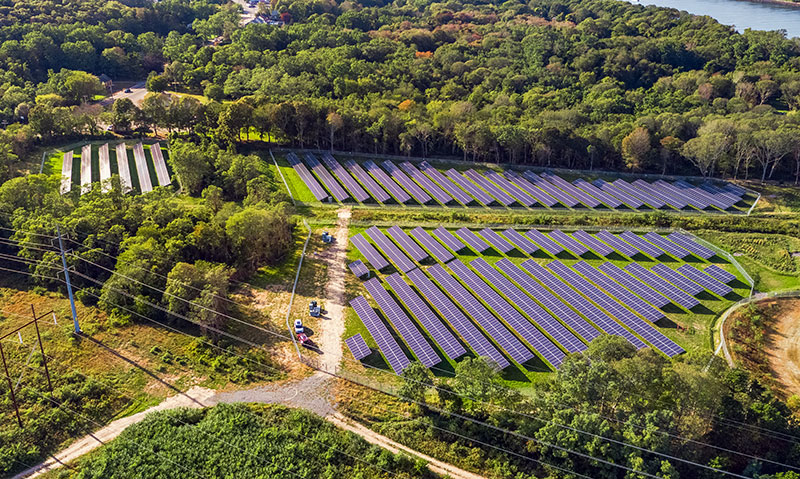
Some pollution you just can’t miss—the oil sheen on a stream, the litter on the side of the road. Many forms of air pollution, however, are invisible. Our human senses cannot tell, for instance, that there is more carbon dioxide in the atmosphere than there was decades ago. In fact, since the Industrial Revolution in the 19th century, the carbon level has jumped from about 280 parts per million to more than 400 now, threatening the stability of our planet’s climate.
Carbon dioxide is the most infamous of the greenhouse gases (GHGs), so named for how they trap heat in the atmosphere. Released by the burning of fossil fuels among other modern human activity, higher levels of GHGs are linked to pollution and changing climate trends.
Understanding air pollution is a first step to getting onto a more sustainable path, in which non-GHG-polluting energy sources, such as solar and hydropower, replace coal, oil and natural gas. Government alliances, on down to the level of individual consumers of energy, have taken up this challenge. Some observers think renewable sources could win out sooner rather than later.
“The future will bring a cleaner energy system because renewables are outcompeting fossil fuels on the criteria consumers care about: cost, reliability and safety,” wrote Dr. Charles Donovan in an online post at the Imperial College Business School in the United Kingdom, where he is the Director of the Centre for Climate Finance and Investment.
Greenhouse Gases 101
In of themselves, greenhouse gases are not pollutants in the same way as, say, heavy metal leaching into waterways. Instead, many GHGs are naturally occurring. For instance, we and other animals produce carbon dioxide in our cells and expel it into the atmosphere. Furthermore, the most powerful GHG, responsible for more warming than all others, is plain old water vapor—the stuff of clouds.
The climate impact can occur, though, when human activity (along with geological activity, such as volcanoes) causes GHGs to accumulate in the atmosphere faster than they are broken down or taken up by the environment. Mechanistically, GHGs absorb heat energy, slowing the rate at which that energy would otherwise radiate out into space.
According to the Environmental Protection Agency, the main GHGs are the aforementioned carbon dioxide, along with methane, nitrous oxide, and fluorinated gases. For purposes of comparison, carbon dioxide is assigned an arbitrary reference value of 1 on the scale of Global Warming Potential (GWP). Methane’s value is between 28 and 36 GWP, depending on the methodology used, over a time period of 100 years. That means that methane absorbs significantly more energy than carbon dioxide, but its effect is more acute than chronic—methane emitted today will likely persist in the atmosphere for a decade, whereas individual carbon dioxide molecules can linger for millennia. The most egregious GHGs, fluorinated gases, meanwhile, do not have natural sources. As products of some manufacturing, for instance, they can have GWPs ranging as high as nearly 23,000.
At present rates of production combined with already-emitted GHGs, climate experts fear warming over by the end of the 21st century by more than 3.6° F (2° C), triggering weather and ecological disruptions, global sea rises, and other impacts.
Turning the Tide on Greenhouse Gases
Across many levels of global society, a push to “decarbonize” and increasingly adopt more sustainable energy solutions is seeing some success. According to the U.S. Energy Information Administration, worldwide energy consumption from renewable sources is conservatively projected to climb a percentage point by 2020 to close to 14 percent, with renewable electricity generation getting close to comprising a quarter of the total. “For the first time in living history, it is possible we will leave fossil fuels in the ground because renewable energy technologies simply do the same job, better,” wrote Donovan.
One of the most promising energy solutions is directly overhead: the ample power of the sun. Sunlight delivers a kilowatt of energy per square meter on the Earth’s surface; all told, that’s 173,000 trillion watts of energy continuously arriving at our planet, some 10,000 times of humanity’s total energy use. “Just as the fossil fuel era had a leading actress (oil) backed up by an important supporting cast (coal and natural gas), so too this new era has its star: solar energy,” states Donovan.
The increasing efficiency of solar cells has brought cost down over the last few decades, and cost still has room to drop—thus increasing adoption—because of so-called soft costs, not related to hardware, representing as much as 64 percent of the total cost of a new solar power system, according to the U.S. Department of Energy’s Solar Energy Technologies Office. Boosting market access, consumer knowledge, and solar technician training could all help make solar more competitive with GHG-producing fossil fuels.
“Some of the most promising opportunities for cost reduction can be found in the balance of systems components, including what are called the ‘soft costs’,” said Jessika Trancik, the Atlantic Richfield Career Development Associate Professor in Energy Studies at the Massachusetts Institute of Technology’s Institute for Data, Systems, and Society.
Another way environmentally-conscious consumers are helping turn the tide on GHGs is through the voluntary purchase of carbon offsets, which as their name implies compensate for GHG emissions. Vendors use carbon offset funds to support renewable energy and other GHG-reduction projects. Companies and governments also employ carbon offsets to comply with mandated caps, for instance under international climate treaties.

Still another solution: chipping into shared energy projects, such as community solar. Thanks to the conveniences of the program, including an offsite farm run by professionals like Clearway Community Solar rather than rooftop panel installation, going solar is far more accessible to residents. Which means more people can support clean energy generation and reduce the dependence on GHGs “This can be a good option in some areas,” said Trancik. “With falling costs of solar hardware, we’re seeing more opportunities open up for tailoring the design of the energy service and supply system to local conditions.”
It is a long road ahead to address the impact of GHGs. Greater awareness of positive steps that can be taken and communities coming together to do their part with programs like Clearway Community Solar are a step into a positive energy future.









